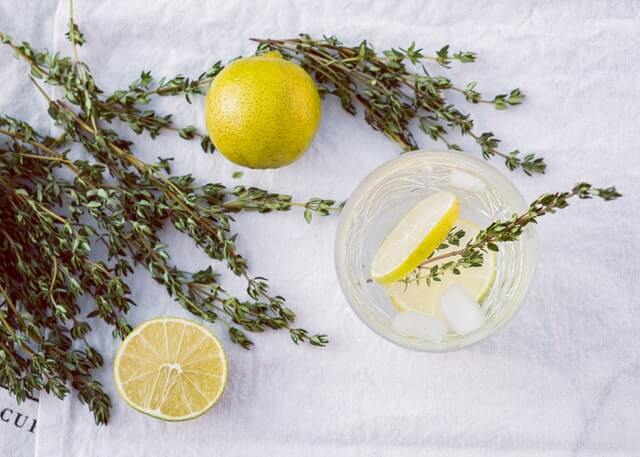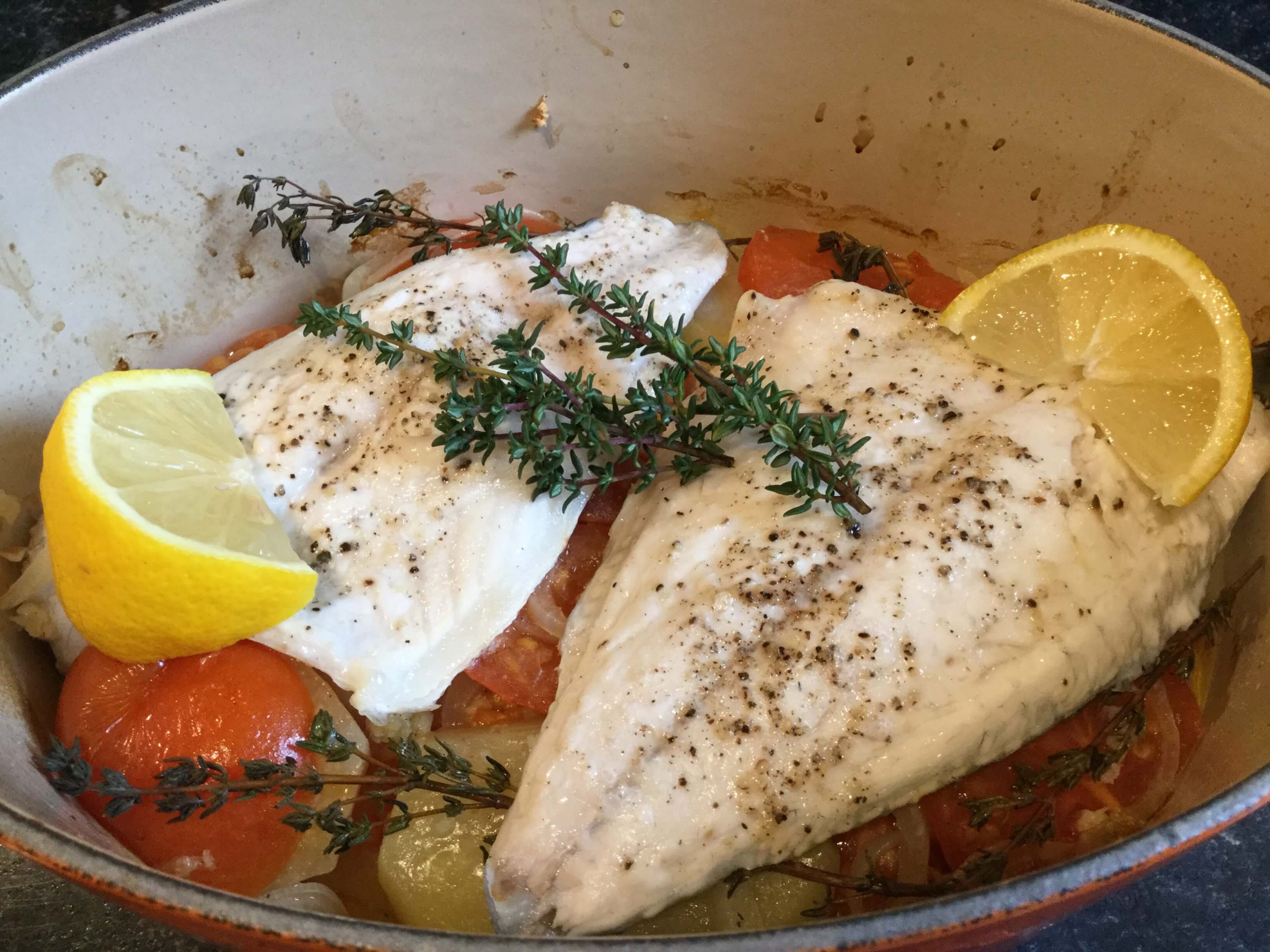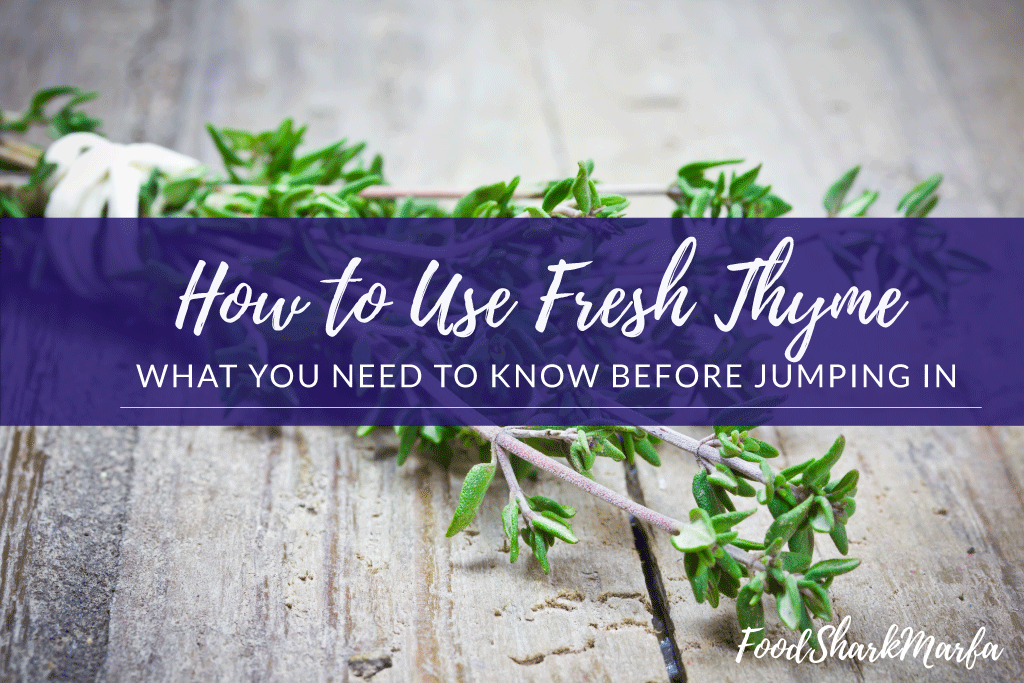Often seen growing in gardens, the versatility of thyme and the aroma and flavors that it brings to recipes should never be underestimated. In this post, I look in more detail at this ancient and flavorful herb and not only consider how it was used in ancient times, but also look at how some of these ancient uses are now supported by scientific and medical professionals.

Although thyme can be used in many dishes, in this step by step tutorial, I have decided to share an easy recipe for a Mediterranean-inspired baked fish which uses ingredients that most of us have available at home.
Benefits of Thyme in The Diet
There are around 300 different varieties of thyme, although many of these are better suited to growing as ground-covering plants rather than eating. Common thyme (Thymus vulgaris), wild thyme (Thymus serpillum), citrus or lemon thyme (Thymus citriodorus) and caraway thyme (Thymus herba-barona) are the main varieties used in cooking in the US.
Thyme was used in foods, beers, as incense and as a medicinal herb by ancient cultures in and around the Mediterranean area. The Ancient Egyptians also used thyme during embalming.
Thyme was considered to represent strength and bravery and Roman soldiers would exchange thyme with each other and even pin it to their clothing before going in to battle. During the Middle Ages, thyme was thought to help protect from infection by the Black Death and it was used to treat the skin lesions that developed when people were infected. These abilities to protect from infection is possibly why thyme was used in food preservation techniques over the centuries.
The reason why thyme has antibacterial actions is because it contains thymol. Thymol is a natural biocide that can kill bacteria and other harmful microorganisms. In fact, thymol is often an ingredient in pesticides for animal pests.
Some researchers have suggested that thymol may be useful in reducing bacterial resistance to drugs such as penicillin and thymol, along with two other natural biocides is able to kill tiger mosquito larvae – tiger mosquitos carry diseases such as dengue fever, yellow fever and West Nile virus.
Thymol has also shown to be able to kill Candida albicans, the fungus responsible for yeast infections or ‘thrush’ and as an essential oil, thyme is helpful against certain foodborne bacteria such as Escherichia and Enterococcus bacteria.
When taken orally, alone or with other herbs, thyme may help relieve symptoms of the common cold, upper respiratory tract infections and bronchitis.

Thyme is likely safe when consumed in food, but those who have bleeding disorders should avoid consuming a large amount of thyme as it may slow blood clotting. It is also recommended that those with hormone-sensitive conditions such as uterine fibroids, breast cancer or ovarian cancer should avoid consuming thyme as it can act like estrogen in the body.
Using Thyme in Recipes
Thyme is a popular herb in many Mediterranean recipes for roasted and grilled fish and meats (often alongside rosemary and sage), in stews, marinades, stocks and soups. Thyme also pairs well with vegetables such as peppers and roasted potatoes.

Thyme is also used in other European cuisines, including French and British, as well as Central and Latin American, and African dishes.
Thyme is in herb blends such as herbes de Provence and bouquet garni, and similar to herbs such as rosemary, it has a concentrated herby flavor with notes of wood, grass and floral. If you use citrus/lemon thyme in cooking, this will also provide stronger citrus notes.
Fresh thyme should always be added to dishes early on in the cooking to allow the oils and flavor of the thyme to be properly released.
Sourcing and Storing Fresh Thyme
Often available fresh as well as dried in grocery stores, you may also be able to grow thyme in your garden. It will also grow well potted indoors. When selecting fresh thyme, look for plenty of bright green leaves on long stems with multiple sprigs.
Fresh thyme can be wrapped in a damp piece of paper towel and stored in a Ziplock bag or similar in the refrigerator. It will usually keep for around two weeks or until the leaves start to brown. If you remove the leaves from the stem, then leaves placed in an airtight container in the refrigerator should keep for around three days.
There is little difference in flavor between fresh and dried thyme, but when using dried thyme, be prepared to add around an extra third of the amount of dried thyme as you would use of fresh thyme. Dried thyme should also be given time to rehydrate in the pan or mix, or if not, then you can rehydrate it in a little warm water before using.
Preparing Fresh Thyme for Cooking
Many recipes using thyme will ask for it in sprigs – the whole form. Probably the easiest way to describe a sprig is a length of stem that contains a number of side branches. As in the recipe below, whole sprigs can be used during cooking and then removed before serving or eating.

If you want to leave thyme in the dish to eat, then you will need to remove the leaves from the stem.
As thyme has a woody stem, this actually makes it easier to strip off the leaves. To do this, just pinch the top of a rinsed sprig between your forefinger and thumb and run the fingers of your other hand down the stem to force the leaves to break off from the stem.
Pro Tip: If the stem of the thyme breaks easily then these softer stems can actually be cut up and added to the pan with the thyme leaves.
As thyme leaves are small, you will rarely need to chop them any smaller - just use the whole leaves.
If you want to bake with fresh thyme (such as for bread) then you will always need to remove the leaves from the stem and chop if necessary. You can also use dried thyme in baking for convenience.
What You Will Need to Follow This Tutorial
In this tutorial, I offer a step by step guide to making a Mediterranean-influenced easy baked fish dish with thyme and lemon. This can be made with any type of white fish. Needing minimal preparation time and around one hour’s cooking; this recipe will provide enough for a two person serving.
Kitchen Tools Needed for Baked Fish with Thyme and Lemon
- Roasting pan – Whatever type of pan you prefer for oven baking and one that is large enough for you to place the fish in it in a single layer.
- Aluminum foil – If your roasting pan does not have a cover then you will also need foil to cover the pan with during cooking.
- Oven mitts – or potholder as required.
- Vegetable peeler/paring knife – To peel the potatoes/onion.
- Chef’s knife – Whatever type of knife you prefer for preparing vegetables with.
- Cutting board – To protect the countertop.
- Garlic mincer – If you do not have a mincer then just crush the garlic cloves with the side of your knife and the heel of your hand.
- Tablespoon – For measuring out olive oil.
Ingredients for Baked Fish with Thyme and Lemon
- 3 all-purpose potatoes.
- 3 medium ripe tomatoes – it is also OK to use some older tomatoes up which are past their best in this recipe.
- 1 medium yellow onion.
- 2 – 3 minced garlic gloves – depending on clove size and preference.
- 6-7 sprigs of thyme - as well as using fresh thyme, you may want to add some fresh rosemary to this dish.
- 1 lemon – you will need a wedge of lemon to squeeze into the dish and the remainder of it for serving up the fish with.
- 4 tablespoons of olive oil – for roasting with.
- Salt and pepper to taste
- White fish – any white fish available. In this recipe I am using around 8 oz (uncooked) of gutted and fileted white fish to for two people.
If you prefer to make this as a main dish without any side, then allow 6 oz or so of white fish per person.

Step by Step Instructions
Step 1: Prepare potatoes
Wash and peel the potatoes and cut into slices around a third of an inch thick. Place to one side of the cutting board.

Step 2: Prepare onion
Peel and very thinly slice the onion and place on one side with the potatoes.

Step 3: Prepare tomatoes
Wash, core and slice the tomatoes into slices around a quarter of an inch thick. Place on one side with the potatoes and onions.
Pro Tip: You can also prepare this recipe, or variations of this recipe using canned chopped tomatoes instead of fresh tomatoes. This will give a richer tomato finish to the dish.

Step 4: Layer vegetables
Turn on the oven to 350°F and add two tablespoons of olive oil to the bottom of your roasting pan.
Add around half of the prepared potatoes to the bottom of the pan in a single layer. Then add a single layer of tomatoes and then onions. Like the potatoes, this should use around half of your prepared tomatoes and onions.

Add salt and pepper as required, then place another single layer of potatoes, then tomatoes, then onions into the roasting pan.
Pro Tip: Although I would usually heat a roasting pan in the oven before adding vegetables, for this recipe, I layer the vegetables in a cold dish. Otherwise, you have to layer with a fork and even doing it this way, there is still a risk of catching your hand on the hot pan.
Step 5: Add the garlic, thyme and lemon
Crush the garlic and spread it onto the vegetables. Wash the lemon, slice in half and squeeze one half over the vegetables. Keep this lemon half to one side – you will need it again.
Finally, rinse the thyme and place three or four sprigs on top of the vegetables along with more black pepper (and salt if required) to taste.
Drizzle the remaining two tablespoons of olive oil over everything.

Add the lid to the roasting pan or cover with aluminum foil. Place the roasting pan in the oven for around 45 minutes at 350°F.
Clean up the cutting board and tools.
Check the potatoes at 30 minutes. If you have sliced them slightly thicker (as I do) for more of an al-dente finish, then check them at 35 minutes but be prepared for an extra ten minutes cooking time.
Step 6: Prepare fish
If your fish is whole, then gut and filet. You can make this dish with whole fileted fish if you prefer; adjusting cooking time as required. I personally prefer to cook it with filets.
Otherwise, if using pre-fileted fish, then a few minutes before the vegetable cooking time is up rinse the filets under cold running water. Sprinkle salt and black pepper as required on each filet. Finally, squeeze some lemon on them using the lemon half that you used in Step 5.

Step 7: Add fish
Take the roasting pan out of the oven and increase the oven temperature to 375°F.
Uncover the vegetables. You will probably find that the potato layer on the base of the dish are cooked, while the second layer are still slightly firmer. Do not panic at this point – they still have another ten minutes or so cooking time at a higher temperature.
Lay the fish on top of the vegetables. Re-cover the roasting pan with its lid or aluminum foil and put back in the oven.

Bake until the fish is cooked – around ten minutes or so – be careful not to overcook.

Pro Tip: When fish is cooked it becomes opaque colored and flaky. To check that fish is done, use a fork to gently push into the thickest part of the filet at a 45 degree angle, twist it and slowly pull some of the fish back up. Fish which is not cooked will not flake.
Step 8: Serve
If you can easily remove the sprigs of thyme before serving then do so, otherwise remove when served. Add your remaining sprigs to the top of the fish and serve up immediately with a wedge of lemon. You can serve as is, or alongside a seasonal green salad and a little crusty bread.

Conclusion
I do hope that you have enjoyed reading about thyme and will find the time (or should that be thyme?) to try out my step by step tutorial for baked fish with thyme and lemon.
Although thyme pairs well with many foods, I always find it goes especially well with fish recipes.
Do feel free to add any comments to the section below and please do share this post with your friends.


